Chord Scales
by btimm (Feb 16, 2011)
In my opinion, this is a great lesson for a beginning guitarist, as it helps the guitarist learn some music theory. It also allows the guitarist to learn some additional chords to add to their arsenal when playing! So let's get started, shall we?
we are going to be using the major scale to do this exercise, so it would be a prerequisite to understand the major scale. If you need to learn about this concept, please check out this lesson, which should really help you on your way:
A Lesson on Major and Minor Scales
Simple enough, we are going to making chords out of each step in the major scale. This is important, because progressions will be easier to perform if you know the chords involved in the progression.
Note: We will be using seventh chords for this lesson, instead of triads. Simply put, seventh chords consist of the root, third, fifth, and seventh notes of a scale. So a seventh chord created using the C Major scale would consist of C, E, G, and A.
Using the Bb Major Scale as an example, we will breakdown how to make the chord scale from the scale itself. Pictures and descriptions of the notes in the scale will be included in this lesson. The Bb major scale has two flats (Bb and Eb) and goes as follows:
Bb-C-D-Eb-F-G-A
The chords in the major scale are I, ii, iii, IV, V, vi, vii.
The root chord is going to be the BbMaj7.
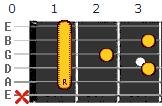
Note here that the notes on each string in this chord as follows:
e --> F
B --> D
G --> A
D --> F
A --> Bb
E --> x
Now to make the second chord, we are going to simply move up each note in the scale! The Bb becomes a C, the F becomes a G, the A becomes a Bb, and the D becomes an Eb! This is the same as the major scale.
e --> G
B --> Eb
G --> Bb
D --> G
A --> C
E --> x
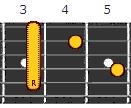
So therefore the second chord in the scale chord is the Cmin7 chord.
Making the third chord follows the same pattern - simply move up one note in the scale to arrive at your third chord in the chord scale, which will be the Dmin7 chord.
e --> A
B --> F
G --> C
D --> A
A --> D
E --> x
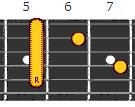
Continue this patern of moving up one note in the scale for this chord as well.
e --> Bb
B --> G
G --> D
D --> Bb
A --> Eb
E --> x
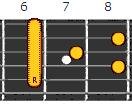
Keep it going!
e --> C
B --> A
G --> Eb
D --> C
A --> F
E --> x
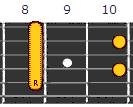
And again!
e --> D
B --> Bb
G --> F
D --> D
A --> G
E --> x
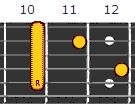
Once more!
e --> Eb
B --> C
G --> G
D --> Eb
A --> A
E --> x

Finally, finish with the root chord once more.
e --> F
B --> D
G --> A
D --> F
A --> Bb
E --> x
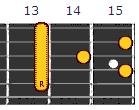
Here is the beauty of chord scales - this works for all scales! Major or minor, or whatever other scale you learn, you can apply the chord scale to those scales as well. In fact, I highly encourage you to do this often. Any time you learn a new chord, you can simply apply this concept to create the chord scale. This will allow you to learn the fingerings for many more chords and just basically become more familiarized with chords and scales, which is the foundation of music.
In fact, go ahead and try this exercise with some other chords you may know like Cmaj7 and Fmaj7!
Cmaj7:
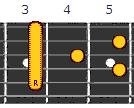
Fmaj7:
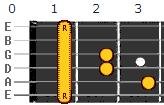
I hope you enjoyed this lesson and that you learned something that may help you as you progress as a guitarist.
Knowing the Scale:
we are going to be using the major scale to do this exercise, so it would be a prerequisite to understand the major scale. If you need to learn about this concept, please check out this lesson, which should really help you on your way:
A Lesson on Major and Minor Scales
Applying Chords to the Scale:
Simple enough, we are going to making chords out of each step in the major scale. This is important, because progressions will be easier to perform if you know the chords involved in the progression.
Note: We will be using seventh chords for this lesson, instead of triads. Simply put, seventh chords consist of the root, third, fifth, and seventh notes of a scale. So a seventh chord created using the C Major scale would consist of C, E, G, and A.
Using the Bb Major Scale as an example, we will breakdown how to make the chord scale from the scale itself. Pictures and descriptions of the notes in the scale will be included in this lesson. The Bb major scale has two flats (Bb and Eb) and goes as follows:
Bb-C-D-Eb-F-G-A
The chords in the major scale are I, ii, iii, IV, V, vi, vii.
The Root Chord: BbMaj7
The root chord is going to be the BbMaj7.

Note here that the notes on each string in this chord as follows:
e --> F
B --> D
G --> A
D --> F
A --> Bb
E --> x
The ii Chord: Cmin7
Now to make the second chord, we are going to simply move up each note in the scale! The Bb becomes a C, the F becomes a G, the A becomes a Bb, and the D becomes an Eb! This is the same as the major scale.
e --> G
B --> Eb
G --> Bb
D --> G
A --> C
E --> x

So therefore the second chord in the scale chord is the Cmin7 chord.
The iii Chord: Dmin7
Making the third chord follows the same pattern - simply move up one note in the scale to arrive at your third chord in the chord scale, which will be the Dmin7 chord.
e --> A
B --> F
G --> C
D --> A
A --> D
E --> x

The IV Chord: EbMaj7
Continue this patern of moving up one note in the scale for this chord as well.
e --> Bb
B --> G
G --> D
D --> Bb
A --> Eb
E --> x

The V Chord: F7
Keep it going!
e --> C
B --> A
G --> Eb
D --> C
A --> F
E --> x

The vi Chord: Gmin7
And again!
e --> D
B --> Bb
G --> F
D --> D
A --> G
E --> x

The VII Chord: Amin7b5
Once more!
e --> Eb
B --> C
G --> G
D --> Eb
A --> A
E --> x

Resolution: Repeating the Root Chord of BbMaj7
Finally, finish with the root chord once more.
e --> F
B --> D
G --> A
D --> F
A --> Bb
E --> x

Okay, but what about other scales??
Here is the beauty of chord scales - this works for all scales! Major or minor, or whatever other scale you learn, you can apply the chord scale to those scales as well. In fact, I highly encourage you to do this often. Any time you learn a new chord, you can simply apply this concept to create the chord scale. This will allow you to learn the fingerings for many more chords and just basically become more familiarized with chords and scales, which is the foundation of music.
In fact, go ahead and try this exercise with some other chords you may know like Cmaj7 and Fmaj7!
Cmaj7:

Fmaj7:

I hope you enjoyed this lesson and that you learned something that may help you as you progress as a guitarist.